
Back to the Index page

About half a dozen members joined the trip to Kilburn. The weather was kind and we had a very enjoyable trip led by Don Buckle, with Jim Pewtress and Nan Sykes on hand with their expertise on birds and plants respectively. We didn’t actually see many birds, but heard plenty including four species of warblers. The walk was in woodland along the lower part of the scarp immediately under the White Horse.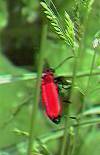 Some of the woodland was of planted conifers, some of more scattered broad-leaved trees plus glades and local wetter or boggy patches. This gave a wide variety of habitats, especially with the track- and pathside edges included. Most of the plants suggest a fairly neutral soil, although there were one or two lime-lovers (e.g. Quaking Grass, which was growing at the track-side near limestone gravel). We recorded 22 birds, almost 70 plants in bud or flower, 15 with leaves only, 4 ferns, 3 sedges and at least 12 grasses, plus 26 trees. We didn’t see very many insects, but there was one splendid cardinal beetle (see right).
Some of the woodland was of planted conifers, some of more scattered broad-leaved trees plus glades and local wetter or boggy patches. This gave a wide variety of habitats, especially with the track- and pathside edges included. Most of the plants suggest a fairly neutral soil, although there were one or two lime-lovers (e.g. Quaking Grass, which was growing at the track-side near limestone gravel). We recorded 22 birds, almost 70 plants in bud or flower, 15 with leaves only, 4 ferns, 3 sedges and at least 12 grasses, plus 26 trees. We didn’t see very many insects, but there was one splendid cardinal beetle (see right).
 We recorded the following:
We recorded the following:

In the dense foliage it was difficult to see the birds, but there were a good number singing. In several places both blackcap and garden warbler were singing close together, which meant we could compare the two songs and try and learn which was which (not an easy task!). We also heard a wood warbler producing both the trilling and the piping variants of its song, and a chiff chaff making a quiet chirrup in between its “chiff-chaffs”. We saw or heard:
Sparrowhawk Kestrel Tawny Owl Swift Blackbird Song Thrush Robin Wren House Martin Blackcap Garden Warbler Chiffchaff Willow Warbler Wood Warbler Goldcrest Long Tailed Tit Blue Tit Great Tit Marsh Tit Carrion Crow Chaffinch Bullfinch
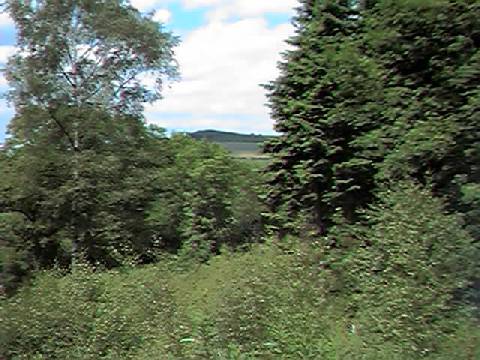
General view (from our lunch spot)
The list below is split into those plants seen in bud or flower, those where only leaves were seen (including ferns and horsetails), grasses and sedges and trees. It is not a complete list of all the plants seen, for instance I did not list all the common species present. I have not listed all the grasses or sedges but have included the easily recognised ones. Nor have I listed trees in any detail.
Back to the Top
| English Name | Latin Name |
|---|---|
| Plants in Bud/Flower | |
| Angelica | Angelica sylvestris |
| Avens, wood | Geum urbanum |
| Bilberry | Vaccinium myrtillus |
Birdsfoot Trefoil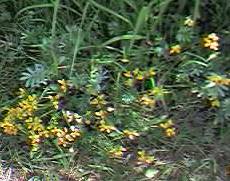 | Lotus corniculatus |
| Bittercress, wavy | Cardamine flexuosa |
| Bluebell | Hyacinthoides nonscripta |
| Bramble | Rubus fruticosus |
Brooklime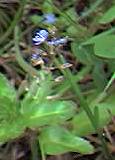 | Veronica beccabunga |
Bugle | Ajuga reptans |
| Burdock | Arctium minus |
| Buttercup, creeping | Ranunculus repens |
| Buttercup meadow | Ranunculus acris |
| Campion, red | Silene dioica |
| Catsear | Hypochaeris radicata |
| Cleavers | Galium aparine |
| Clover, red | Trifolium pratense |
| Clover, white | Trifolium repens |
| Cow parsley | Anthriscus sylvestris |
| Crosswort | Galium cruciata |
| Dandelion | Taraxacum sp. |
| Dock | Rumex sp. |
| Eyebright | Euphrasia officinalis agg. |
| Figwort, common | Scrophularia nodosa |
| Figwort, water | Scrophularia auriculata |
| Forgetmenot, field | Myosotis arvensis |
| Forgetmenot, wood | Myosotis sylvatica |
Foxglove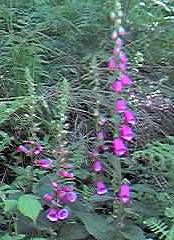 | Digitalis purpurea |
| Gorse | Ulex europaeus |
| Herb robert | Geranium robertianum |
| Hogweed | Heracleum sphondylium |
| Honeysuckle | Lonicera periclymenum |
Lady’s mantle | Alchemilla sp. |
| Meadowsweet | Filipendula ulmaria |
| Meadow vetchling | Lathyrus pratensis |
| Medick, black | Medicago lupulina |
| Milkmaid | Cardamine pratense |
| Mouse ear, common | Cerastium fontanum |
Orchid, common spotted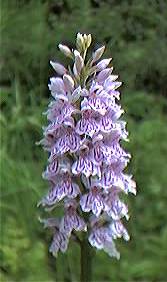 | Dactylorhiza fuchsii |
| Plantain, greater | Plantago major |
| Plantain, ribwort | Plantago lanceolata |
Ragged robin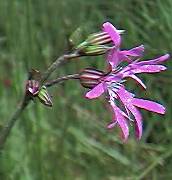 | Lychnis flos-cuculi |
| Raspberry | Rubus idaeus |
| Rose, dog | Rosa canina |
| Rose, hybrid downy | Rosa sp. |
| Rush, hard | Juncus inflexus |
| Rush, soft | Juncus effusus |
| Rush, jointed | Juncus articulatus |
Silverweed | Potentilla anserina |
| Sorrel, common | Rumex acetosa |
| Sowthistle, rough | Sonchus asper |
| Spearwort, lesser | Ranunculus flammula |
| Speedwell, germander | Veronica chamaedrys |
Speedwell, heath | Veronica officinalis |
Speedwell, thyme leaved | Veronica serpyllifolia |
| Starwort | Callitriche agg. |
| Stitchwort, bog | Stellaria uliginosa |
| Stitchwort, greater | Stellaria holostea |
| Stitchwort, lesser | Stellaria graminea |
| St Johnswort,common or perforate | Hypericum perforatum |
| Strawberry, barren | Potentilla sterilis |
Strawberry, wild | Fragaria vesca |
| Thistle, marsh | Cirsium palustre |
Tormentil | Potentilla erecta |
| Valerian, common | Valeriana officinalis |
| Valerian, marsh | Valeriana dioica |
| Willowherb, great | Epilobium hirsutum |
| Willow herb, probably broad-leafed | Epilobium sp. |
| Woundwort, hedge | Stachys sylvatica |
| Yellow pimpernel | Lysimachia nemorum |
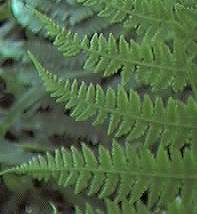
 There were several different ferns, including the delicate Lady Fern (part of a frond, left). This can be told from Male fern and the Buckler ferns by the comma-shaped spore masses on the underside of the leaves (right).
There were several different ferns, including the delicate Lady Fern (part of a frond, left). This can be told from Male fern and the Buckler ferns by the comma-shaped spore masses on the underside of the leaves (right).
| Plants (Leaves only, Ferns and Horsetails) | Cinquefoil, creeping | Potentilla reptans |
| Coltsfoot | Tussilago farfara |
| Dogs mercury | Mercurialis perennis |
| Garlic or Ramsons | Allium ursinum |
| Heather or Ling | Calluna vulgaris |
| Ivy | Hedera helix |
| Lady’s bedstraw | Galium verum |
| Lords and ladies | Arum maculatum |
| Nettle | Urtica dioica |
| Ragwort, common | Senecio jacobea |
| Rosebay | Chamaenerion angustifolium |
| Thistle, creeping | Cirsium arvense |
| Violet, probably dog | Viola sp. |
| Wood sage | Teucrium scorodonia |
| Wood sorrel | Oxalis acetosella |
| Bracken | Pteridium aquilinum |
| Broad Buckler Fern | Dryopteris dilatata |
| Lady Fern | Athyrium filix-femina |
| Male Fern | Dryopteris filix-mas |
| Field Horsetail (?) | Equisetum arvense |
| Marsh Horsetail | Equisetum palustre |
| Wood Horsetail | Equisetum sylvaticum |
| Grasses and Sedges | |
| Cocksfoot | Dactylis glomerata |
| Crested Dogstail | Cynosurus cristatus |
| Fescue | Festuca sp. |
| Hair Grass, Tufted | Deschampsia caespitosa |
| Meadow Grass, Rough | Poa trivialis |
| Meadow Grass, Smooth | Poa pratensis |
| Oat, False | Arrhenatherum elatius |
| Quaking Grass | Briza media |
| Rye grass | Lolium sp. |
| Sweet Vernal Grass | Anthoxanthum odoratum |
| Timothy | Phleum pratense |
| Yorkshire Fog | Holcus lanatus |
| Sedge, Glaucous | Carex flacca |
| Sedge, Hairy | Carex hirta |
| Sedge, Remote | Carex remota |
There is a wide variety of trees in the woodland, much of it planted. Many of the species are introductions (including all the conifers except Scots Pine). Two of the most interesting specimens we saw are a Robinia and a conifer which was possibly a Cryptomeria but some members thought it was a Sequoiadendron.
| Trees and Shrubs | |
| “Acacia” | Robinia pseudoacacia |
| Alder | Alnus glutinosa |
| Ash | Fraxinus excelsior |
| Blackthorn | Prunus spinosa |
| Birch (Silver) | Betula pendula |
| Cherry | Prunus avium |
| Crab Apple | Malus sylvestris |
| ?Cryptomeria | Cryptomeria japonica |
| Eared Willow | Salix aurita |
| Elder | Sambucus nigra |
| Field Maple | Acer campestre |
| ?Giant Sequoia | Sequoiadendron giganteum |
| Guelder Rose | Viburnum opulus |
| Hawthorn | Crataegus monogyna |
| Hazel | Corylus avellana |
| Hemlock (Western) | Tsuga heterophylla |
| Larch | Larix sp. |
| Oak | Quercus sp. |
| Rowan | Sorbus aucuparia |
| Scots Pine | Pinus sylvestris |
| Silver Fir | Abies alba |
| Spruce, Norway | Picea abies |
| Spruce, Sitka | Picea sitchensis |
| Sycamore | Acer pseudoplatanus |
| Western Red Cedar | Thuja plicata |
| Willows (several) | Salix spp. |
| Wych Elm | Ulmus glabra |
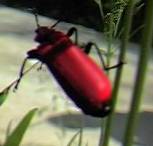

We did not identify many insects, but we did see a blue damsel-fly (right), a white butterfly (?large white) and a spectacular cardinal beetle Pyrochroa coccinea, which flew across the path and then posed for us on a grass stalk (left).
All photos © copyright 1999 Gill & Adrian Smith
Back to the Top and Index page
© Ryedale Natural History Society 1999